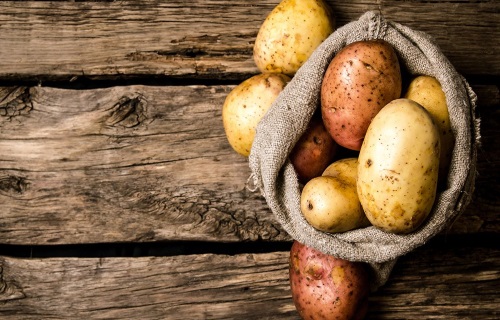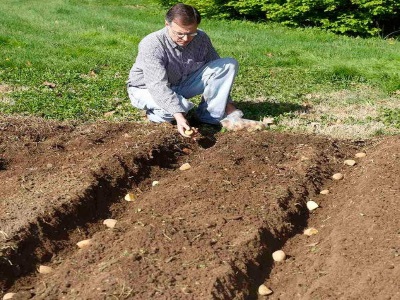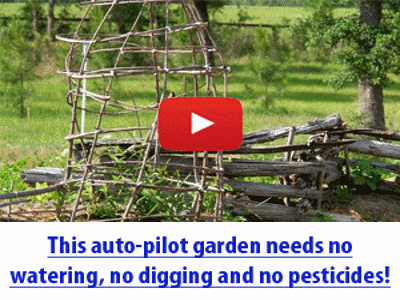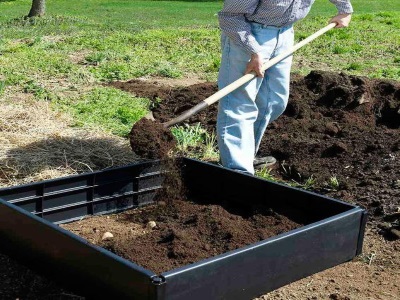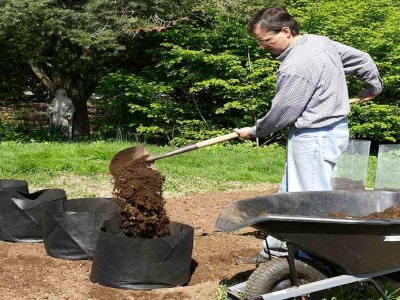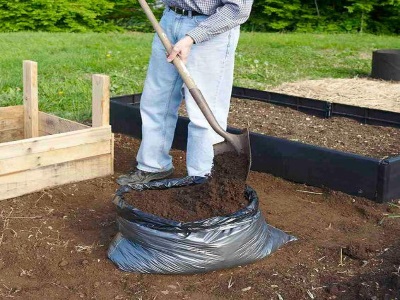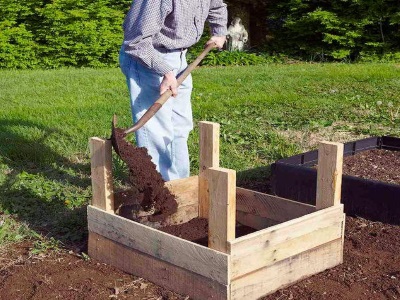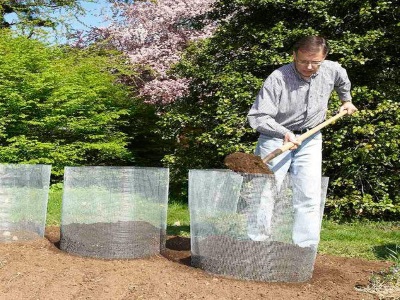A few years ago, I was planting potatoes of the German Butterball variety, using a variety of planting methods. Through the course of the growing season, the benefits and drawbacks of each became quite clear. Read on to discover which of the seven growing methods worked best, and which ones were subpar.
Dig straight, shallow trenches, two to three feet apart, in prepared soil. Plant seed potatoes 12 inches apart and cover with about 3 inches of soil. When the shoots reach 10 to 12 inches tall, use a hoe or shovel to scoop soil from between rows and mound it against the plants, burying the stems halfway. Repeat as needed through the growing season to keep the tubers covered.
The benefit of this growing method is that it is not done by container gardening, so there is nothing to buy or build and no soil to transport. This is a simple, inexpensive, and proven method that farmers have used for millennia. It is practical for large-scale plantings, also. However, the yield may be limited by the quality of the soil. In places where the soil is badly compacted or low in organic matter, an above-ground technique might work better.
Here’s a video that shows this potato-planting method:
Place seed potatoes on the surface of prepared soil, following the spacing specified for hilled rows, and cover them with three to four inches of loose, seed-free straw. Mound more straw around the stems as they grow, eventually creating a layer of one foot or more in depth.
The benefit of this method is that the thick mulch conserves soil moisture and smothers weeds. Harvest is effortless with no digging, and this method is suggested as a way to thwart Colorado potato beetle. However, our yield in the test plot was slightly less than in the hilled row and field mice have been known to use the cover of straw to consume the crop.
Loosen the soil in the bottom of a half-filled raised bed. Space seed potatoes about 12 inches apart in all directions and bury them 3 inches deep. As the potatoes grow, add more soil until the bed is filled. If possible, simplify harvest by removing the sides. This method yielded the largest harvest in my trials, and the potatoes were uniformly large in size. Raised beds are a good choice where the garden soil is heavy and poorly drained. The downside: the soil to fill the bed has to come from somewhere—and it takes a lot.
Commercial growing bags are constructed of heavy, dense polypropylene. Put a few inches of a soil-compost mixture in the bottom of a bag, then plant three or four seed potato pieces and cover with three inches of soil. Continue adding soil as the plants grow until the bag is filled. To harvest, turn the bag on its side and dump out the contents.
Grow Bags can be placed on patios or driveways or used where garden soil is of inferior quality. The bags should last for several growing seasons. Their dark color captures solar heat to speed early growth. Harvest is simple, and the yield can be impressive, considering the small space each bag occupies. However, this can be a pricy technique. The brand of bag I used costs $12.95.
Plant a large plastic garbage bag following the instructions for a grow bag, punching a few holes through the plastic for drainage. Roll the top edge of the bag to help it stay upright, otherwise the bag is prone to sag and spill soil. To harvest, rip the bag and dump out the contents.
Like the grow bags, a garbage bag can be employed where in-ground growing is not an option. Black bags capture solar heat to speed early growth. Aesthetically, however, this is the least appealing choice. Our yield was meager, perhaps because the thin plastic allowed the soil to heat up too much, limiting tuber formation.
Build a bottomless square box—I used lumber from discarded pallets—and plant the same as for a raised bed. The box is designed so additional slats can be screwed to the sides as the plants grow and soil is added. In theory, a bottom slat can be temporarily removed to facilitate the harvest of new potatoes. For the final harvest, tip the box and dump out its contents.
This is another raised strategy for growing potatoes where the garden soil is of poor quality. Our yield was similar in quantity to that of a raised bed. However, a lot of time and effort went into the construction of the box and I felt the results did not justify the effort.
Using hardware cloth with ¼-inch mesh, fashion a cylinder about 18 inches in diameter and 24 inches tall. Put several inches of soil in the bottom, then plant three or four seed potatoes and cover them with three inches of soil. Continue to add soil as the potatoes grow. To harvest, lift the cylinder and pull the soil back to expose the tubers.
In a climate with incessant spring rains, the wire mesh would provide excellent drainage and prevent the soil from becoming waterlogged. This is another raised technique to consider where garden soil is poor. Unfortunately, though, I harvested a limited number of undersized tubers from the cylinders—a dismal showing, probably because the soil-compost mixture I used dried out so quickly that the plants lacked adequate moisture.
“MY SURVIVAL FARM”
…and it’s like nothing you’ve ever seen before… An A to Z guide on survival gardening that is easy to read and a joy to put into practice, full of photos, diagrams and step by step advice. Even a kid can do this and, in fact, I encourage you to let the little ones handle it, to teach them not just about self-reliance but also about how Mother Nature works.
Here is just a glimpse of what you’ll find inside:
How to plan, design and put into action high-yield survival garden that will literally keep you and your family fed for life, no matter what hits you, even when everyone else around you is starving to death. No digging and planting year after year and no daily watering because you’ll have more important things to worry about when TSHTF.
How to set up highly nutritious soil for your plants. Do this before you plant anything and you’re on your way to setting your food forest on auto-pilot for decades to come. I’m gonna tell you this one “weird” thing to add to the mulch that’s not only highly effective but also 100% free (because you already have it in your home right now).
Step-by-step instructions on how to plant over 125 plants inside your permaculture garden. Plus, special instructions on choosing the right ones for your climate. From Arizona to Alaska, you can do this anywhere…
How to “marry” your plants. We’re gonna tell you which grow well together and help each-other survive and thrive, so they don’t ever compete for sunlight and nutrients. You get the full table of plants that work well with one another as well as the ones you should NEVER be put together. (Source)
Our grandfathers had more knowledge than any of us today and thrived even when modern conveniences were not available. They were able to produce and store their food for long periods of time. The Lost Ways is the most comprehensive book available. All the knowledge our grandfathers had, in one place.Here’s just a glimpse of what you’ll find in the book:
Table Of Contents:
Making Your Own Beverages: Beer to Stronger Stuff
Ginger Beer: Making Soda the Old Fashioned Way
How North American Indians and Early Pioneers Made Pemmican
Wild West Guns for SHTF and a Guide to Rolling Your Own Ammo
How Our Forefathers Built Their Sawmills, Grain Mills,and Stamping Mills
How Our Ancestors Made Herbal Poultice to Heal Their Wounds
What Our Ancestors Were Foraging For? or How to Wildcraft Your Table
How North California Native Americans Built Their Semi-subterranean Roundhouses
Our Ancestors’Guide to Root Cellars
Good Old Fashioned Cooking on an Open Flame
Learning from Our Ancestors How to Preserve Water
Learning from Our Ancestors How to Take Care of Our Hygiene When There Isn’t Anything to Buy
How and Why I Prefer to Make Soap with Modern Ingredients
Temporarily Installing a Wood-Burning Stove during Emergencies
Making Traditional and Survival Bark Bread…….
Trapping in Winter for Beaver and Muskrat Just like Our Forefathers Did
How to Make a Smokehouse and Smoke Fish
Survival Lessons From The Donner Party
Get your paperback copy HERE
Here’s just a glimpse of what you’ll find in The Lost Ways:
From Ruff Simons, an old west history expert and former deputy, you’ll learn the techniques and methods used by the wise sheriffs from the frontiers to defend an entire village despite being outnumbered and outgunned by gangs of robbers and bandits, and how you can use their wisdom to defend your home against looters when you’ll be surrounded.
Native American ERIK BAINBRIDGE – who took part in the reconstruction of the native village of Kule Loklo in California, will show you how Native Americans build the subterranean roundhouse, an underground house that today will serve you as a storm shelter, a perfectly camouflaged hideout, or a bunker. It can easily shelter three to four families, so how will you feel if, when all hell breaks loose, you’ll be able to call all your loved ones and offer them guidance and shelter? Besides that, the subterranean roundhouse makes an awesome root cellar where you can keep all your food and water reserves year-round.
From Shannon Azares you’ll learn how sailors from the XVII century preserved water in their ships for months on end, even years and how you can use this method to preserve clean water for your family cost-free.
Mike Searson – who is a Firearm and Old West history expert – will show you what to do when there is no more ammo to be had, how people who wandered the West managed to hunt eight deer with six bullets, and why their supply of ammo never ran out. Remember the panic buying in the first half of 2013? That was nothing compared to what’s going to precede the collapse.
From Susan Morrow, an ex-science teacher and chemist, you’ll master “The Art of Poultice.” She says, “If you really explore the ingredients from which our forefathers made poultices, you’ll be totally surprised by the similarities with modern medicines.” Well…how would you feel in a crisis to be the only one from the group knowledgeable about this lost skill? When there are no more antibiotics, people will turn to you to save their ill children’s lives.
If you liked our video tutorial on how to make Pemmican, then you’ll love this: I will show you how to make another superfood that our troops were using in the Independence war, and even George Washington ate on several occasions. This food never goes bad. And I’m not talking about honey or vinegar. I’m talking about real food! The awesome part is that you can make this food in just 10 minutes and I’m pretty sure that you already have the ingredients in your house right now.
Really, this is all just a peek.
The Lost Ways is a far–reaching book with chapters ranging from simple things like making tasty bark-bread-like people did when there was no food-to building a traditional backyard smokehouse… and many, many, many more!
Books can be your best pre-collapse investment.
The Lost Ways (Learn the long forgotten secrets that helped our forefathers survive famines,wars,economic crisis and anything else life threw at them)
Survival MD (Best Post Collapse First Aid Survival Guide Ever)
Conquering the coming collapse (Financial advice and preparedness )
Liberty Generator (Build and make your own energy source)
Backyard Liberty (Easy and cheap DIY Aquaponic system to grow your organic and living food bank)
Bullet Proof Home (A Prepper’s Guide in Safeguarding a Home )
Family Self Defense (Best Self Defense Strategies For You And Your Family)
Survive Any Crisis (Best Items To Hoard For A Long Term Crisis)
Survive The End Days (Biggest Cover Up Of Our President)

